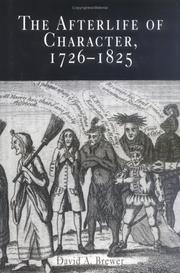| Listing 1 - 1 of 1 |
Sort by
|

ISBN: 0812238648 9786613211507 1283211505 0812201434 9780812201437 9780812238648 Year: 2005 Volume: *5 Publisher: Philadelphia, Pa University of Pennsylvania Press
Abstract | Keywords | Export | Availability | Bookmark
 Loading...
Loading...Choose an application
- Reference Manager
- EndNote
- RefWorks (Direct export to RefWorks)
The Afterlife of Character, 1726-1825 reconstructs how eighteenth-century British readers invented further adventures for beloved characters, including Gulliver, Falstaff, Pamela, and Tristram Shandy. Far from being close-ended and self-contained, the novels and plays in which these characters first appeared were treated by many as merely a starting point, a collective reference perpetually inviting augmentation through an astonishing wealth of unauthorized sequels. Characters became an inexhaustible form of common property, despite their patent authorship. Readers endowed them with value, knowing all the while that others were doing the same and so were collectively forging a new mode of virtual community. By tracing these practices, David A. Brewer shows how the literary canon emerged as much "from below" as out of any of the institutions that have been credited with their invention. Indeed, he reveals the astonishing degree to which authors had to cajole readers into granting them authority over their own creations, authority that seems self-evident to a modern audience. In its innovative methodology and its unprecedented attention to the productive interplay between the audience, the book as a material artifact, and the text as an immaterial entity, The Afterlife of Character, 1726-1825 offers a compelling new approach to eighteenth-century studies, the history of the book, and the very idea of character itself.
Sociology of literature --- English literature --- anno 1700-1799 --- anno 1800-1899 --- Caractères litteraires --- Caractères littéraires --- Character sketches--History and criticism --- Characterization (Literature) --- Characters [Literary ] --- Characters and characteristics in literature --- Karakterisering (Literatuur) --- Karakters [Literaire ] --- Karakters in de literatuur --- Karakterschetsen in de literatuur --- Literaire karakters --- Literaire portretten --- Literary characters --- Literary portraits --- Littérature--Personnages --- Personages in de literatuur --- Personnages (littérature) --- Personnages littéraires --- Portraits [Literary ] --- Portraits littéraires --- Portretten [Literaire ] --- Sequels (Literature) --- Suites (Litterature) --- Types littéraires --- Vervolgen (Literatuur) --- Influence (Literary, artistic, etc.) --- Authors and readers --- Intellectual property --- Character sketches --- Portraits, Literary --- IP (Intellectual property) --- Proprietary rights --- Rights, Proprietary --- Intangible property --- Artistic impact --- Artistic influence --- Impact (Literary, artistic, etc.) --- Literary impact --- Literary influence --- Literary tradition --- Tradition (Literature) --- Art --- Influence (Psychology) --- Literature --- Intermediality --- Intertextuality --- Originality in literature --- Readers and authors --- Authorship --- Cycles (Literature) --- History --- History and criticism --- Law and legislation --- E-books --- 18th century --- Great Britain --- 19th century --- Characters and characteristics in literature. --- History and criticism. --- Authors and readers. --- English literature. --- Fortleben. --- Influence (Literary, artistic, etc.). --- Influence littéraire, artistique, etc --- Intellectual property. --- Intellectueel eigendom. --- LITERARY CRITICISM --- Leser. --- Lezers. --- Literarische Gestalt. --- Literatur. --- Littérature anglaise --- Personnages dans la littérature. --- Propriété intellectuelle --- Rezeption. --- Schrijvers. --- Sequels (Literature). --- Séries (Littérature). --- Écrivains et lecteurs --- Histoire --- European --- English, Irish, Scottish, Welsh. --- Histoire et critique --- 1700-1899. --- Geschichte 1726-1825. --- Englisch. --- Great Britain. --- Gro�britannien. --- Verenigd Koninkrijk van Groot-Brittannië en Noord-Ierland.
| Listing 1 - 1 of 1 |
Sort by
|

 Search
Search Feedback
Feedback About UniCat
About UniCat  Help
Help News
News